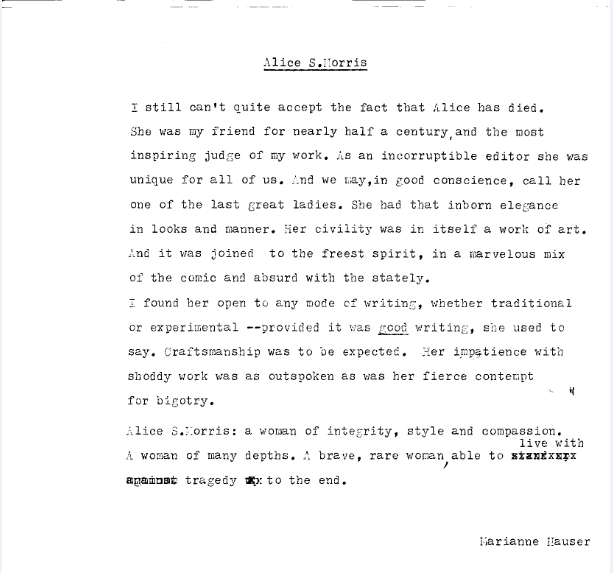Alice S. Morris was one of Marianne Hauser’s closest personal friends, and she was also a vitally important professional friend. Morris was the literary editor at Harper’s Bazaar from 1951-1968 and she published many of Hauser’s stories, as well as excerpts from her novel Prince Ishmael. In 1965 she edited The Uncommon Reader, a collection of Harper’s Bazaar stories which includes Hauser’s The Abduction, an hallucinatory journey into exile taken by a Hungarian composer. It is based largely on the life of Erno Dohnanyi, whom she knew in the 1950’s, in Tallahassee, where he was teaching and where Fred Kirchberger got his PhD. Morris died at age 90 in 1993. Alice S. Morris was one of several adventurous mid-century editors at fashion magazines. These women’s magazines became a market for serious literary fiction. She was preceded by George Davis, who was at Harper’s Bazaar from 1936-1941, who then moved to Mademoiselle until 1949. Betsy Blackwell was the editor and chief of Mademoiselle from 1937-1971. Mademoiselle was a Conde Nast publication, which for a time was a partner of McBride’s, where Coby Gilman worked editing Travel. Carson McCullers, Truman Capote, Jean Stafford, Eudora Welty, Flannery O’Connor, James Baldwin, Jane Bowles, Paul Bowles, and Tennessee Williams are some of the many authors published by these fashion magazines early in their careers. When Hauser published Dark Dominion her friend Marguerite Young reviewed it in Vogue alongside McCullers’ A Member of the Wedding and Capote’s short stories.
Morris was married to Harvey Breit, a novelist and editor who reviewed books for the Times in the 40’s (his Times obit gives different dates than the Wikipedia article for his NYT tenure). When she died, Hauser wrote this about her old friend:


i would like to send you a photo that i have—- side of a horse drawn delivery wagon in chicago with “Marianne now in the evening American”
with a drawn portrait of her
Dale, fantastic! I’ll email.
couldnt find the email—–call me 708 483-2191
do NOT email please
I did not know Ms. Hauser, but I was privileged to be a student of Alice Morris at extension classes which met at night at The New School in New York. I twice took her class in the mid-80s and once she invited some students to her home for an evening of reading and drinks. I’ll never forget the sound of her voice, or, rather, the soothing, friendly basis of it. When she read our work she made it sound elegant, polished and exceptional. Maybe it was, sometimes. Her voice exalted it all, always. She encouraged me to pursue publication and to this extremely insecure writer, there was no better teacher nor there ever will be. Her compliments to me were jewels.
Peter,thank you so much for your comment and for reading. She was certainly an important editor before she taught at the New School and encouraged women especially. Marianne Hauser spoke of her in every interview I’ve read as well as in her autobiographical essay, and dedicated her book Me and My Mom to her. You were a lucky student. I wish I had met her. –Jon